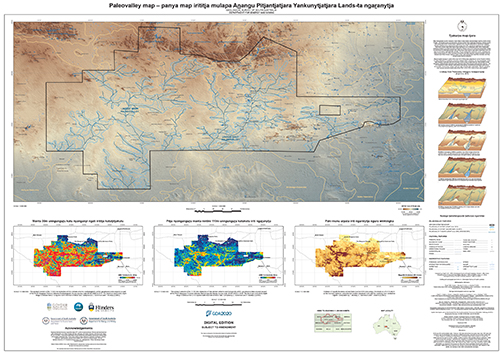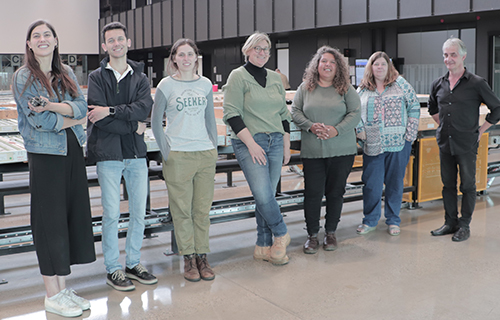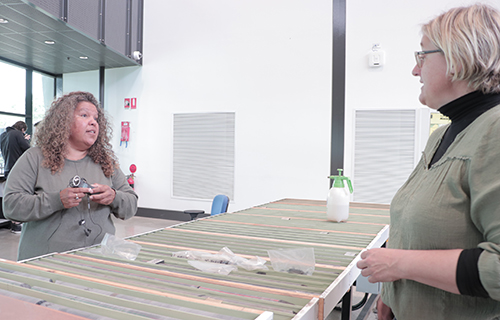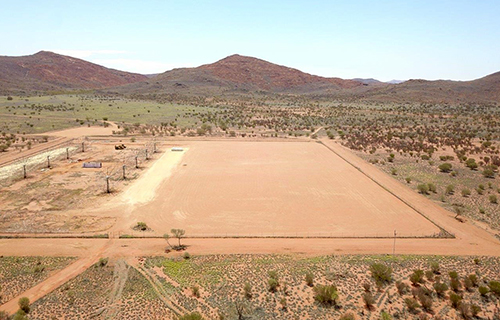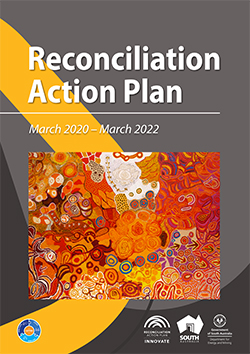Sharing knowledge in language and transforming power.
Panya map irititja mulapa Anangu Pitjantjatjara Yankunytjatjara Lands-ta ngaranytja
The Department for Energy and Mining (DEM) is proud to publish a geological map in an Aboriginal language for the first time. The recently released palaeovalley map of the Anangu Pitjantjatjara Yankunytjatjara (APY) Lands, South Australia, has been translated into Pitjantjatjara by the Iwiri Aboriginal Corporation. This broadscale map serves as a guide for more detailed future hydrogeological investigation to unlock additional groundwater resources.
A picture story about the project was also published for Anangu to accompany the map so that they can see how the project was undertaken and understand its footprint on country.
Making this information accessible to the local community encourages two-way communication and promotes understanding of the work of DEM’s Geological Survey of South Australia and the value of undertaking geoscience.
The translated map aligns with DEM’s commitment to ensure Aboriginal people can participate fully in the energy and mining sectors, and to support their communities’ aspirations for a positive future – see DEM’s Reconciliation Action plan below.
The paleovalley map is a product of the Goyder Institute for Water Research’s Facilitating Long-term Outback Water Solutions (G-FLOWS) project Phase 3, a partnership between the Department for Environment and Water, CSIRO, Flinders University, DEM and the Geological Survey.
Through this project the discovery of new potable groundwater resources near Kaltjiti (Fregon) – see October 2020 MESA Journal – has the potential to create new opportunities for the Fregon community.
Printed copies to Anangu of the map in Pitjantjatjara will be available via the Umuwa APY Board office. Both the English and Pitjantjatjara versions of the palaeovalley map can be downloaded via the South Australian Resources Information Gateway (SARIG).
Language and land
In a further expansion of our relationships with Aboriginal people, DEM hosted a filming crew from the Mobile Language Team of the University of Adelaide at the South Australia Drill Core Reference Library for a project that draws together Aboriginal ways of thinking and western scientific concepts of country and geology. A selection of drill core samples from across the APY Lands were on display for viewing.
Eleanor McCall (Mobile Language Team linguist), Julian Rawirri Kusabs (PhD candidate), Lucinda Duxbury (Intern with ‘Language and Learn’ project), Carmen Krapf (Geological Survey) and Karina Lester (Mobile Language Team film interviewer) with DEM’s Heidi Crow (Principal Policy Officer, Aboriginal Heritage and Engagement) and David Groom (Manager of the South Australia Drill Core Reference Library). (Photo 418299)
Lucinda Duxbury, postgraduate student in Earth Sciences, is undertaking a project on ‘Language and Land’ that seeks to use language to bridge two-way understandings of landscape formation and change. The project will also better inform Aboriginal communities about exploration drilling, mapping and other scientific techniques conducted on country.
For Karina Lester, Yankunytjatjara woman and co-manager of the Mobile Language Team, the visit provided an opportunity to examine drill core samples from her country around the Everard and Indulkana Ranges. The Mobile Language Team filmed Geological Survey Senior Geologist, Dr Carmen Krapf, sharing her geological knowledge and stories with Karina, who translated it into Yankunytjatjara. At the same time Karina shared her stories of country with Carmen and both discovered that some of their stories complemented each other’s.
Karina Lester (Mobile Language Team) and Carmen Krapf (Geological Survey) examine drill core samples from the APY Lands. (Photo 418298)
The video will be used as an information and training tool for Anangu to communicate what geologists do, why they are so interested in learning about the geology of the APY Lands and how they see country through different eyes. An interesting insight was that although geologists have many names for stone, Anangu only have one name for stone – apu in Pitjantjatjara. For them the landscape is a cultural landscape, alive with ancestral beings who formed the landscape and its features that gave it the names still used today.
Transforming energy generation
We are also working with Anangu on a project to enhance electricity supplies to the APY Lands. The project, part of DEM’s Remote Area Energy Supply scheme, involves upgrading the existing 5 megawatt (MW) diesel plant at the Central Power House at Umuwa and installation of renewable power infrastructure for the first time. The planned 3 MW solar farm and 1 MW battery will deliver 4.4 gigawatts hours of clean renewable electricity to the local community, reducing diesel consumption by about one-third.
Project works are being carried out by Next Generation Electrical with the company committed to sourcing 30% of its labour needs from Anangu businesses. Work has started at the diesel plant where obsolete control systems are being replaced with state-of-the-art technology and communications to improve reliability and reduce outage periods. Installation of the solar farm and battery is expected to start early 2021 with full operation expected by year end.
Earlier this year DEM contracted Regional Anangu Services Aboriginal Corporation to carry out high-quality essential site works in preparation for the solar farm and battery. (Photo 418301)
Reconciliation Action Plan
DEM launched its Reconciliation Action Plan, March 2020 – March 2022 earlier this year. It identifies three priority areas:
- Relationships: Engaging with and building relationships with Aboriginal people will strengthen our capacity to work collaboratively towards improved outcomes.
- Respect: Recognising the contribution of Aboriginal people to Australia enabling DEM to achieve more culturally inclusive outcomes and actively cultivate behaviours that enhance our workplace and guide the development and delivery of services.
- Opportunities: Creating opportunities for Aboriginal people and increasing Aboriginal economic participation and equity.
These projects demonstrate DEM’s commitment to building culturally inclusive outcomes into our operations.
– Carmen Krapf, Heidi Crow and Steven Bye, December 2020


